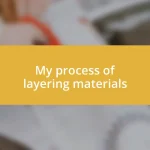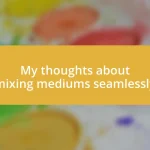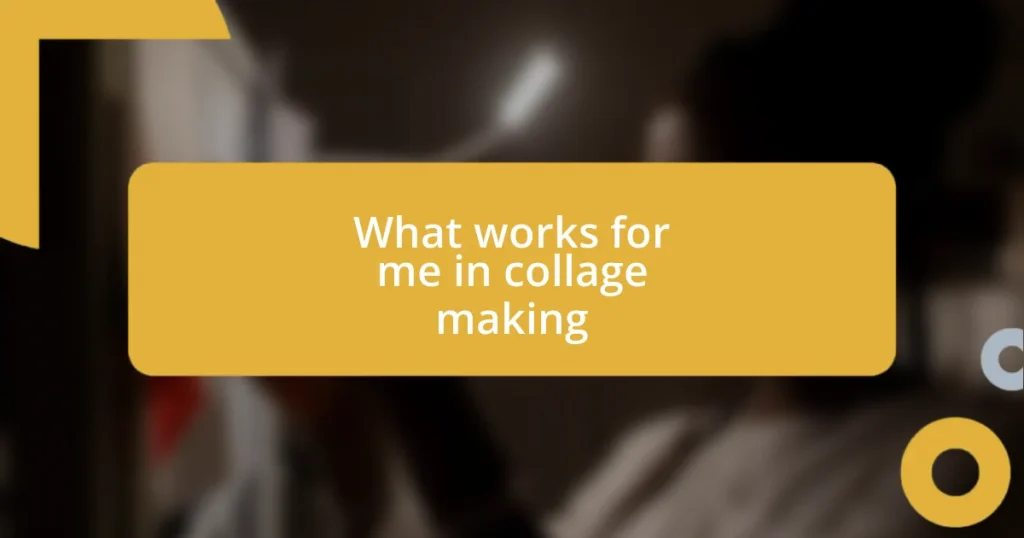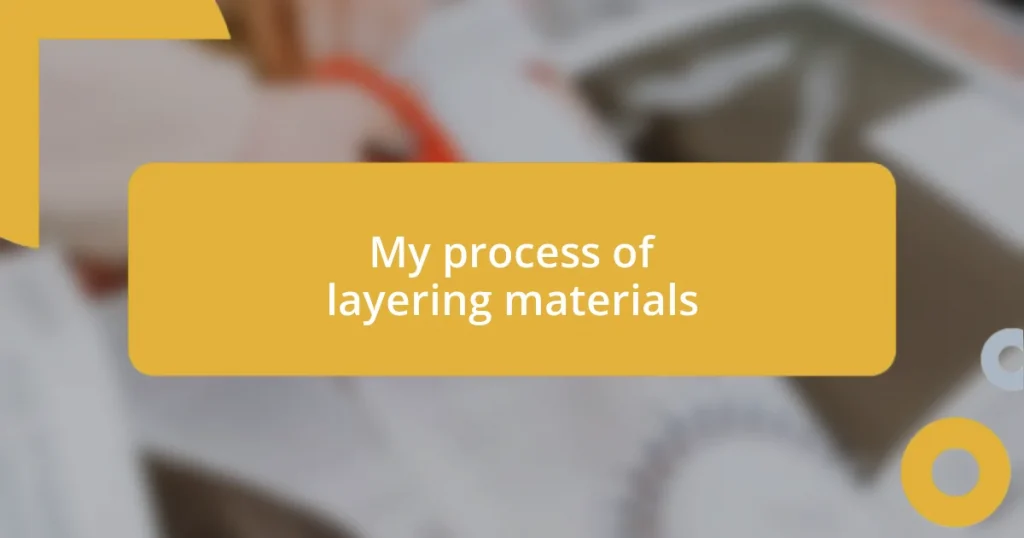Key takeaways:
- Collage making is a personal and emotional artistic journey that encourages experimentation with materials and techniques.
- Essential materials include a variety of paper types, effective adhesives, and unique embellishments that add depth and personal history to collages.
- Incorporating personal style and themes, along with seeking inspiration from resources like Pinterest and art communities, can elevate the collage-making experience.

Understanding collage making
Collage making is a fascinating blend of art and personal expression. I remember the first time I created a collage; it was like opening a door to my emotions. Each piece I chose reflected a part of my story, capturing memories in a way that words sometimes can’t.
What I truly appreciate about collaging is how it invites you to experiment and play. Have you ever felt overwhelmed by a blank canvas? That’s where collaging shines. You can cut, layer, and rearrange images and textures, all while exploring what resonates with you. The practice feels freeing, as if the materials themselves are guiding you toward something deeper within.
Every collage tells a unique narrative, often shaped by the materials you choose. When I sift through old magazines or photographs, I feel an excitement bubbling up—like a treasure hunt for inspiration. It’s amazing how different colors and patterns can stir emotions or memories, don’t you think? Embracing this understanding is what makes collage creation not just an art form but a deeply personal journey.

Essential materials for collages
When it comes to essential materials for collages, variety is key. I’ve found that a mix of papers, from vintage newspapers to colorful scrapbook sheets, creates a dynamic visual experience. The texture of these materials often adds depth; remember that moment when you found a beautifully aged paper that just spoke to you? Those little details can transform a simple collage into something truly special.
Additionally, adhesives play a pivotal role in the creation process. I gravitate towards glue sticks for their ease of use, but I always keep a bottle of liquid glue handy for those heavier materials. It’s a fascinating balance—too little glue and your pieces may lift, too much can lead to unfortunate messes. Have you ever been frustrated by a collage falling apart? That’s a lesson I learned quickly; finding the right adhesive can make all the difference in your artistic journey.
Beyond the basics, I love incorporating embellishments such as fabric scraps, beads, or even buttons. These unexpected additions can bring a collage to life, adding elements of surprise that keep the viewer engaged. Once, I used some old lace from a dress I no longer wore which not only added a touch of femininity but also evoked fond memories of wearing it long ago. Each added layer is like a stroke of a brush, painting a richer story.
| Essential Materials | Description |
|---|---|
| Paper Variety | Different textures and colors; vintage newspapers, scrapbook sheets, etc. |
| Adhesives | Glue sticks for ease; liquid glue for heavier items. |
| Embellishments | Fabric, beads, buttons; adds depth and personal history. |

Techniques for effective collage design
In collage making, balance is everything. There’s a thrill in discovering how different elements interact on the canvas. I recall once placing a bold, bright image next to a soft, faded one. The contrast created a dialogue between the two, elevating my entire piece. Finding that perfect interplay can lead to surprising results that evoke feelings and invite reflection.
Here are a few techniques that have worked particularly well for me:
- Layering: Experiment with overlapping images and materials to build depth and intrigue.
- Contrast: Mix bold and subtle elements to create tension and interest.
- Theme Consistency: Stick to a central theme to unify your collage, but allow room for serendipity.
- Focal Points: Highlight a central image or texture that draws the viewer’s eye, creating a narrative.
- Negative Space: Don’t forget to leave some blank areas; they can provide breathing room and enhance the overall composition.
When I gotta pull all those pieces together, I find doodling ideas in a sketchbook beforehand really helps clear my mind. Just the act of putting pencil to paper allows me to brainstorm without pressure. Isn’t it curious how a simple sketch can shape the final vision? It’s like laying the groundwork for my emotional landscape before bringing it to life with collage.

Tips for organizing collage elements
To effectively organize your collage elements, creating a designated workspace can make a world of difference. I’ve found that a clean, well-lit area not only fosters creativity but also helps in laying out materials in an aesthetically pleasing manner. When I spread out my papers and embellishments, I often find myself playing with combinations, almost like a kid in a candy store—who doesn’t love to visually explore their options?
Categorizing elements by type or color works wonders too. When I tackle a new collage, I usually lay out all my papers in one section and my embellishments in another. This way, I can quickly see what I have, and it speeds up the selection process. Have you ever experienced that delightful moment when you stumble upon the perfect piece tucked away that you forgot you had? The excitement of re-discovering materials truly reinvigorates the creative process!
Another tip is to clip or pin down pieces to a board before committing to glue. I remember a time I was hesitant about a placement, so I used a corkboard to arrange my elements first. This trial-and-error method allowed me to step back and see the overall look from a distance. It’s amazing how those small adjustments can shift the energy of a piece. It’s often the tiniest tweak that transforms a collage from good to wow! How do you approach the balancing act of placement? Sometimes, all it takes is a fresh perspective.

Ways to incorporate personal style
Incorporating personal style into your collages can really elevate them to a new level. For me, it’s all about reflecting who I am through my choices. One time, I used snippets of poetry that resonated with my experiences, combining them with images of nature. That blend not only showcased my love for words but also created a deeply personal narrative that felt authentic to me. Have you thought about how your favorite quotes or memories could add depth to your collages?
Another way to express your personal style is through color palettes. When I first started, I often found myself drawn to warm, earthy tones as they mirrored my love for nature. Over time, I’ve ventured into brighter hues that reflect my energetic side. This personal evolution in my color choices not only speaks to my journey but also transforms the mood of each piece. What colors resonate with you, and how might they tell your story?
Finally, textural choices can really highlight your individual style. I remember one collage where I mixed different materials—like fabric, paper, and found objects—to add dimension. The roughness of the fabric contrasted beautifully with the smoothness of the paper, reflecting both my yin and yang. It’s curious how texture can evoke emotions—certain materials can feel nostalgic or energizing. Have you experimented with textures in your collages yet?

Suggestions for themed collages
When it comes to themed collages, I often think about how a cohesive concept can make your creation stand out. For example, I once worked on a travel-themed collage where I used photographs, maps, and even ticket stubs to evoke memories from various trips I’ve taken. It became more than just pretty images; it was a visual storytelling piece that transported me back to those joyous moments. Have you ever considered how your experiences could guide your collage themes?
Another suggestion is to explore a specific season or holiday. Last autumn, I created a collage centered around fall—think pumpkins, vibrant leaves, and cozy sweaters. Gathering elements related to this theme allowed me to fully immerse myself in the warmth of the season. I even included snippets of my favorite fall recipes, which made the piece both visually appealing and meaningful. What themes resonate with you during different times of the year, and how might you express that through collage?
If you’re feeling adventurous, how about crafting a “time capsule” collage? I once dedicated a piece to my high school memories by incorporating clippings from my yearbook, photos of me and my friends, and even notes from classes. This collage not only represented a moment in time but also sparked a wave of nostalgia as I revisited those memories. It was fascinating to see how such a snapshot could evoke a spectrum of emotions. What snapshots of your life would you choose to immortalize in a collage?

Resources for collage inspiration
In my journey of collage-making, I’ve found various resources incredible for sparking inspiration. One of my favorite places to visit is Pinterest. I love scrolling through endless boards filled with creative ideas and unique styles. Each time I dive into that ocean of visuals, I discover new techniques or themes that immediately ignite my imagination. Have you ever stumbled upon a collage that completely shifted your creative direction?
Another resource that has transformed my approach is art books and magazines. There was a time when I borrowed a book on modern art from my local library, which opened my eyes to unconventional arrangements and unexpected materials. The boldness of the artists inspired me to take risks with my collages. It’s amazing how seeing a different medium can propel you toward innovative ideas. What publications have influenced your artistic ventures?
Finally, I can’t stress enough the value of online communities. Joining a Facebook group dedicated to collage enthusiasts was a game changer for me. Members share their work, offer critiques, and exchange tips on techniques or materials. That collaborative spirit not only motivates me but also strengthens my own skills. Have you ever engaged with fellow artists? It might just lead to your next big breakthrough!














